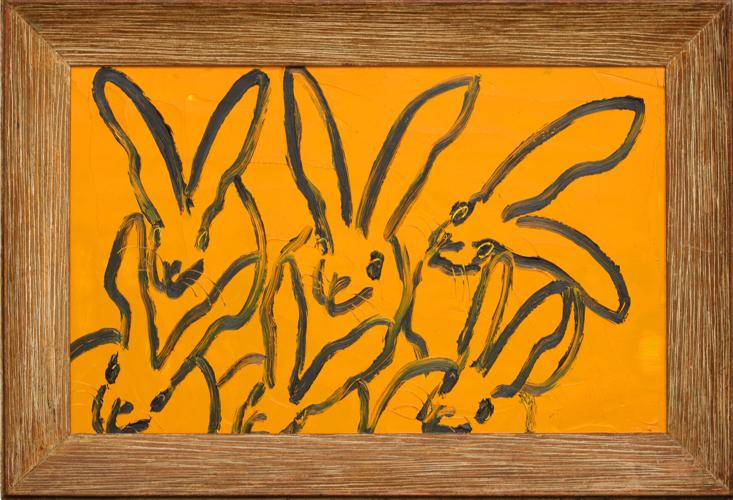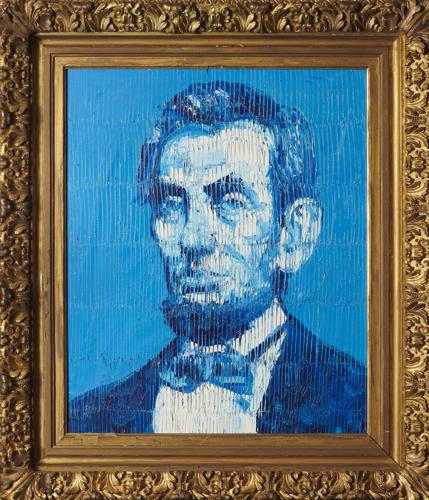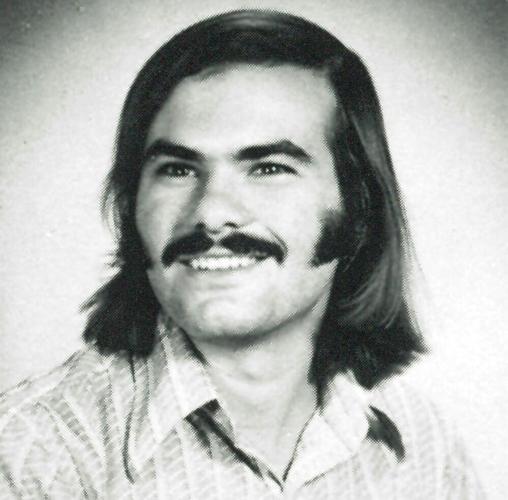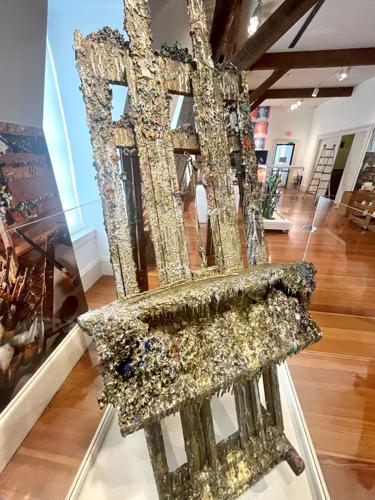Just look at artist Hunt Slonem’s easel. It’s like a natural wonder, encrusted with thick mounds of spilled and splattered oil paint, built up layer after layer, like the Mississippi River built up its delta in South Louisiana. The easel, dripping with oil stalactites, is a centerpiece of the Slonem retrospective on display upstairs in the Cabildo, on Jackson Square.
As the easel indicates, Slonem is anything but fussy. He slathers his canvases with buttery layers of paint. And whether his subject is a dreamy landscape, a floppy-eared bunny or a portrait of Abraham Lincoln, he renders it with bold, no-holds-barred brushstrokes. Slonem’s brand of breezy expressionism has made him an art world star, maybe around the world, but nowhere more so than in Louisiana.
About 40 years ago, Slonem adopted the Bayou State, and eventually the Bayou State adopted him back. In 1951, he was born in faraway frosty Maine, but thanks to his dad’s profession as a naval engineer, he’s lived here and there around the coastal parts of the country, including heavenly Hawaii, which, he said, probably sparked his lifelong fascination with tropical birds.

Hunt Slonem's paint-encrusted easel is a centerpiece of his retrospective exhibit at the Cabildo
Slonem probably caught the art bug from his grandfather, a landscape painter. In the early '70s, Slonem (wearing shoulder-length hair, muttonchop sideburns, and a David Crosby mustache) attended Tulane University, where he honed his painterly skills, as he got swept up in the mystique of antique Louisiana architecture. Especially the magnificent, moldering plantation homes.
Later, in the 21st century, after he’d become a bigtime artist (he once produced a Slonem product line for the tony Bergdorf Goodman department store), he bought and restored three of the spooky old places: Madewood, Albania and Lakeside plantations.
As previously mentioned, Slonem loves birds. He kept, and maybe still keeps, a big cage of them at his New York studio, studying their characteristic shapes and colors as he works.
Often, after having swiftly painted a flock of the feathery creatures, he slices through the still-wet paint with a thin brush or maybe a palette knife to produce a grid that imitates the birds’ screen enclosure. The screen pattern produces an oozy cake-frosting texture that your fingers just long to touch — though the docents at the Cabildo would rather you didn’t.

Hunt Slonem's 2022 painting 'Lories, The Visit,' includes his characteristic grid pattern 'cut' into the surface of the wet paint
Like his tropical colors, Slonem’s seductive textures are certainly part of the appeal of his work. What’s interesting, is that he sometimes applies that same, seemingly melting, grid to swamp-scapes and historical portraits that don’t have anything to do with bird cages. Asked how the screen effect applies to nonavian paintings, Slonem said that the grid “added a modernist element” to his works.
But there’s probably more to it. Slonem explained that he calls the grid pattern “a veil.” Which for him, probably means the veil between the distant past and the present, or between the living and the dead.
Slonem has long included historical subjects in his works, from Rudolph Valentino to Winston Churchill to Queen Elizabeth II. He’s interested in various forms of spiritualism and feels it’s possible to have a certain kinship with otherworldly entities. That mystical component in his life and artwork is definitely part of the allure. It adds a supernatural resonance to the naturalism of his subject matter.

Hunt Slonem's 'President Lincoln' from 2020 includes his signature modernist grid pattern, which in this case may represent the 'veil' between the present and the past, or between the living and dead
It’s difficult to categorize Slonem’s style. Neo-expressionism fits the bill pretty well, since Slonem came of age artistically in the era Clemete, Schnabel and Basquiat. Though his work doesn’t seem as dour as those other dudes. There’s a sense of joie de vivre in most of the works in Slonem’s Cabildo retrospective, all of which curator Cybele Gontar gathered from Louisiana collections.
Jefferson Parish businessman and art collector Henry Shane is a big fan of Slonem’s work. Shane and wife Pat arranged for the huge Louisiana landscapes by Slonem hung inside the Jefferson Performing Art Center, and the Slonem sculptures on Veterans Boulevard and in Lafreniere Park. And they’re credited with having helped bring about the current show.
The survey of Slonem’s career at the Cabildo isn’t one of those contemporary art shows where you’ll find yourself petting your chin in contemplation, while you’re actually checking your watch to see if it’s time to leave yet.

'Dawn' from 2019 is one of Hunt Slonem's large (9 by 9 feet), expressionistic Louisiana landscapes
Based on an early preview, the retrospective is a visual all-you-can-eat buffet, with scads of big, delightfully messy paintings, a wooden sculpture or two, plus some added attractions, like an array of glass bunnies (that weren’t unpacked yet, during an early visit), and a couple of very charming ten-foot, plastic, topiary bunnies near the stairs that lead to the show.
“Hunt Slonem: A Retrospective,” continues through Sept. 30, 2024, at the Louisiana State Museum at the Cabildo, located at 710 Chartres St., on Jackson Square in the French Quarter. Hours are Tuesday through Sunday, 9 a.m. to 4 p.m. Tickets are $10, $8 for seniors and military. For more information, visit the LSM website.

Plastic topiary bunnies greet visitors at the Hunt Slonem exhibit at the Cabildo











